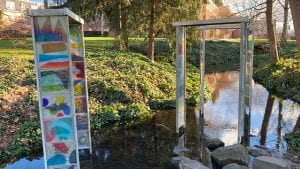Our Place in Walla Walla #10: Asian-Americans
This past weekend was Lunar New Year for many Asian cultures and events celebrated this moment both on campus and in the Walla Walla community. For example, Mika Means ’05 and her partner Peter Means in Technology Services helped lead efforts at Crazy Love Church to celebrate Walla Walla’s Asian community at an annual Lunar New Year party.
Not all Asians celebrate the new year at this time. For instance, since 1873, the official Japanese New Year has been celebrated according to the Gregorian calendar, on January 1. However, the holiday provides a timely opportunity to begin to learn a few important points about the Asian and Asian-American community in the Walla Walla Valley.
To begin, this community is a small part of the overall demographic. The 2023 Census predictions lists about 2% of the population of Walla Walla County identifying as “Asian alone” (meaning persons reporting only one race).
The largest Asian group that has been in the valley is from China and there is considerable documentation about Chinese immigrants arriving in Walla Walla to support the gold mining in the 1850s and 60s. One scholar estimated that “the local Chinese population in Walla Walla may have been as high as 1,250 at one time but numbered only 50 or 60 in 1973…” They faced racism and hostility from white residents. Mountain View Cemetery off 2nd Avenue has a section where Chinese residents were buried which makes for an excellent excursion from campus. The Heritage Park Windows on the Past history wall contains numerous images from the Chinese community in Walla Walla.
I asked colleagues on campus and in Walla Walla what they thought members of the Whitman community would want to know about Walla Walla’s Chinese and Chinese-American residents:
From Susan Holme, Senior Director, Off-Campus Studies & International Student and Scholar Services, and a self-described life-long student of China:
“It might be interesting to note that there was a significant community of children, mostly girls, adopted from China by families in Walla Walla and College Place in the early 2000s. It was probably about 40 or so children in total. Each year, adoptive families in College Place held a large Chinese New Year Celebration open to all families in the valley with children adopted from China to introduce the children and families to Chinese traditions. Also, starting in 2007, Wencui Zhao, Senior Lecturer of Asian and Middle Eastern Studies, opened a small Chinese after school program for families interested in having their children learn Mandarin at a young age. Many children adopted from China here in the valley got their first exposure to Mandarin language and Chinese characters in those classes, since there is no Chinese language offered in the Walla Walla Public Schools.”
From Susan Monahan, local historian and researcher focusing on Chinese residents in Walla Walla:
“I would share with others what we used to have, which is a vital and active Chinese community. It is timely that part one of my three articles on the Chinese New Year is scheduled to appear Feb 10 in the U-B, the first day of the Chinese New Year. In it I describe a large Chinese community, which today, due to a number of factors, no longer exists. This is of course to be regretted. Most residents are aware, I hope, that we had such a community, but most would be surprised at how large a group they were and how much they contributed to the town of Walla Walla. My goal is to collect all the documents available and to share through writing the contributions of our Chinese community to our town.”
(Read more from this Feb 10 Union Bulletin article on Chinese New Years in Walla Walla)
In addition to Chinese immigrants, other Asian populations arrived in Walla Walla, including from Japan and the Philippines. These residents often worked in agriculture and farming. These populations were much smaller, with one master’s thesis on the history of Japanese in the Seattle area stating that in 1880, there was only one Japanese person in the entire region and they were living here in Walla Walla. In the late 1920s, the city of Walla Walla—then population 15,000—had 13 Japanese residents.
One terrible chapter in American history—the internment of Japanese-American citizens during WWII under the Roosevelt Administration, affected families in Walla Walla, causing them to be relocated to the Minidoka internment camp in Idaho. Families in our community have shared these powerful stories that would be relevant for students to learn about as they are learning about our place.
Whitman has a direct experience with this dark time in America, with student Robert Hosokawa, who graduated in 1940 and then returned to his family’s home, where in 1941 he was sent to Minidoka. As our college’s website notes, “Robert and his wife were allowed to leave their internment camp in Idaho only after one of his former Whitman professors helped find him a job at a newspaper in Independence, Missouri…“
Local resident and retired WWCC chief academic officer or Vice President of Instruction (VPI) Marleen Ramsey recently published a powerful novel about the experience of a young Walla Walla Japanese American girl whose family experienced this tragedy that is worth a read. (Ramsey was born in Seoul, orphaned during the Korean War, was adopted by an American family, and grew up in western Oregon. In addition, Walla Walla resident Teresa Tamura has published a powerful photojournalism work about Minidoka and has shared her work at Whitman.
Readers, today’s post is of course not a comprehensive history but just some interesting aspects of our community that might provoke further curiosity and study. I would enjoy hearing what else you learn about Asian-American residents of the Walla Walla Valley—perhaps for inclusion in a column in April!
